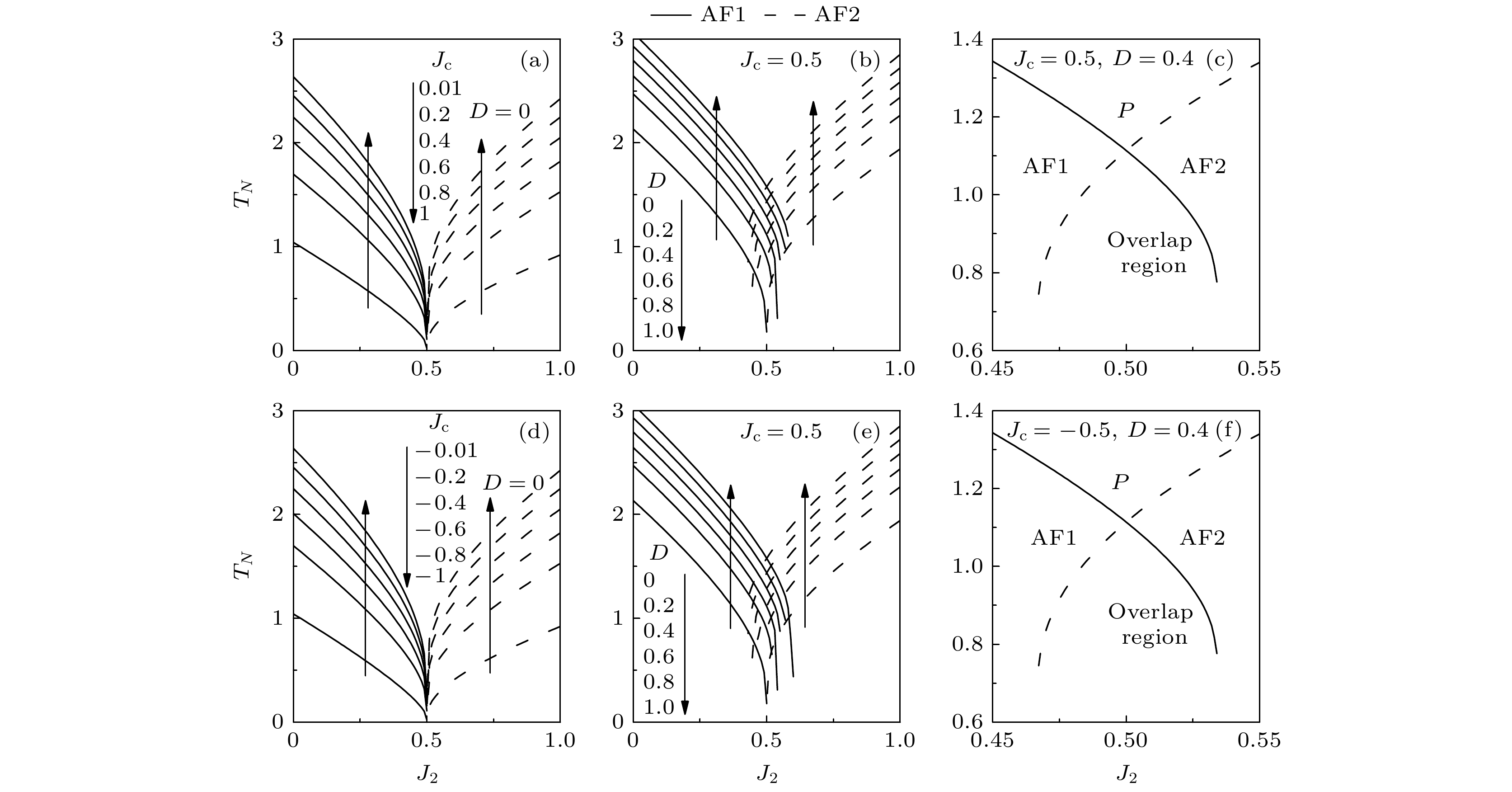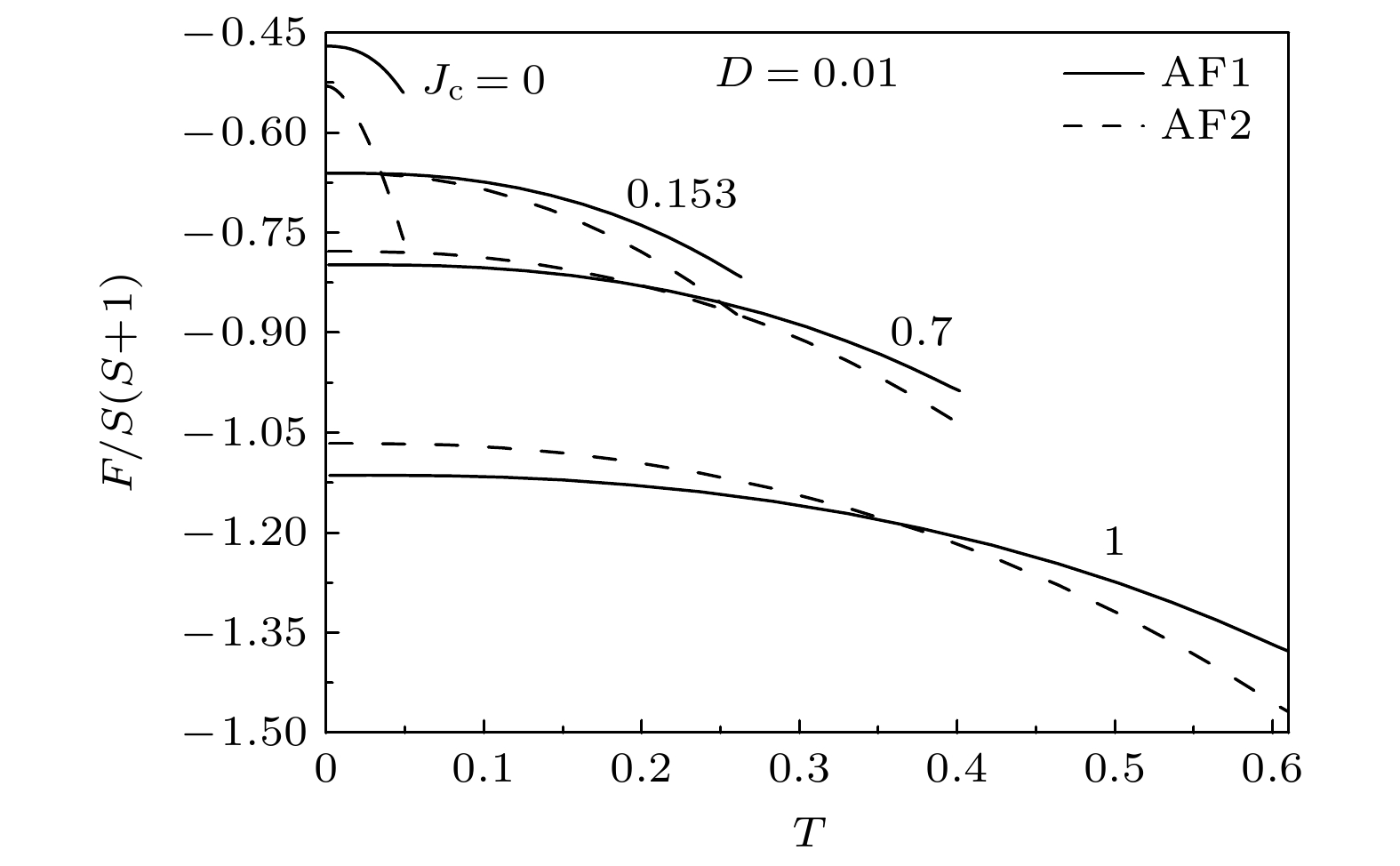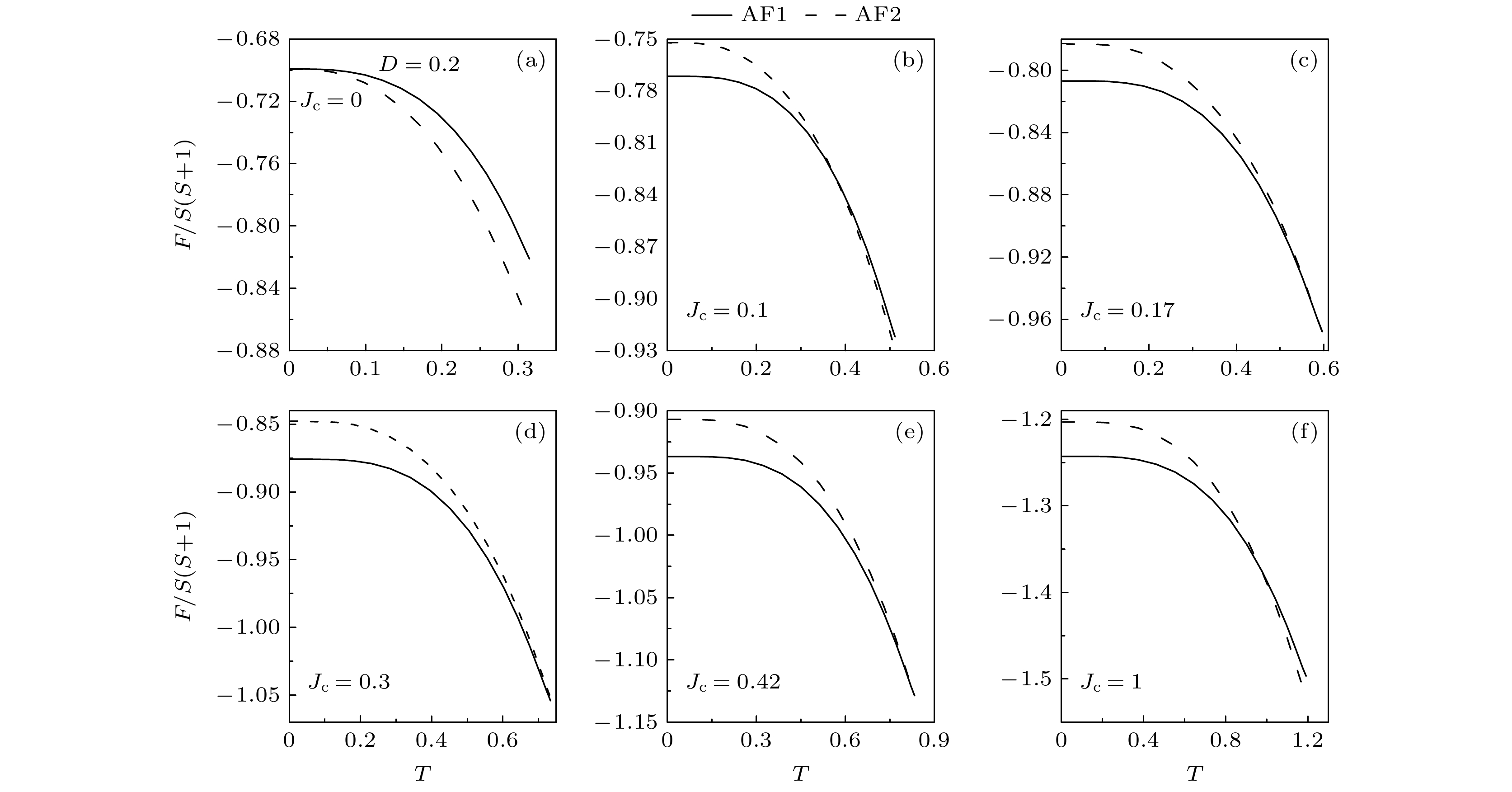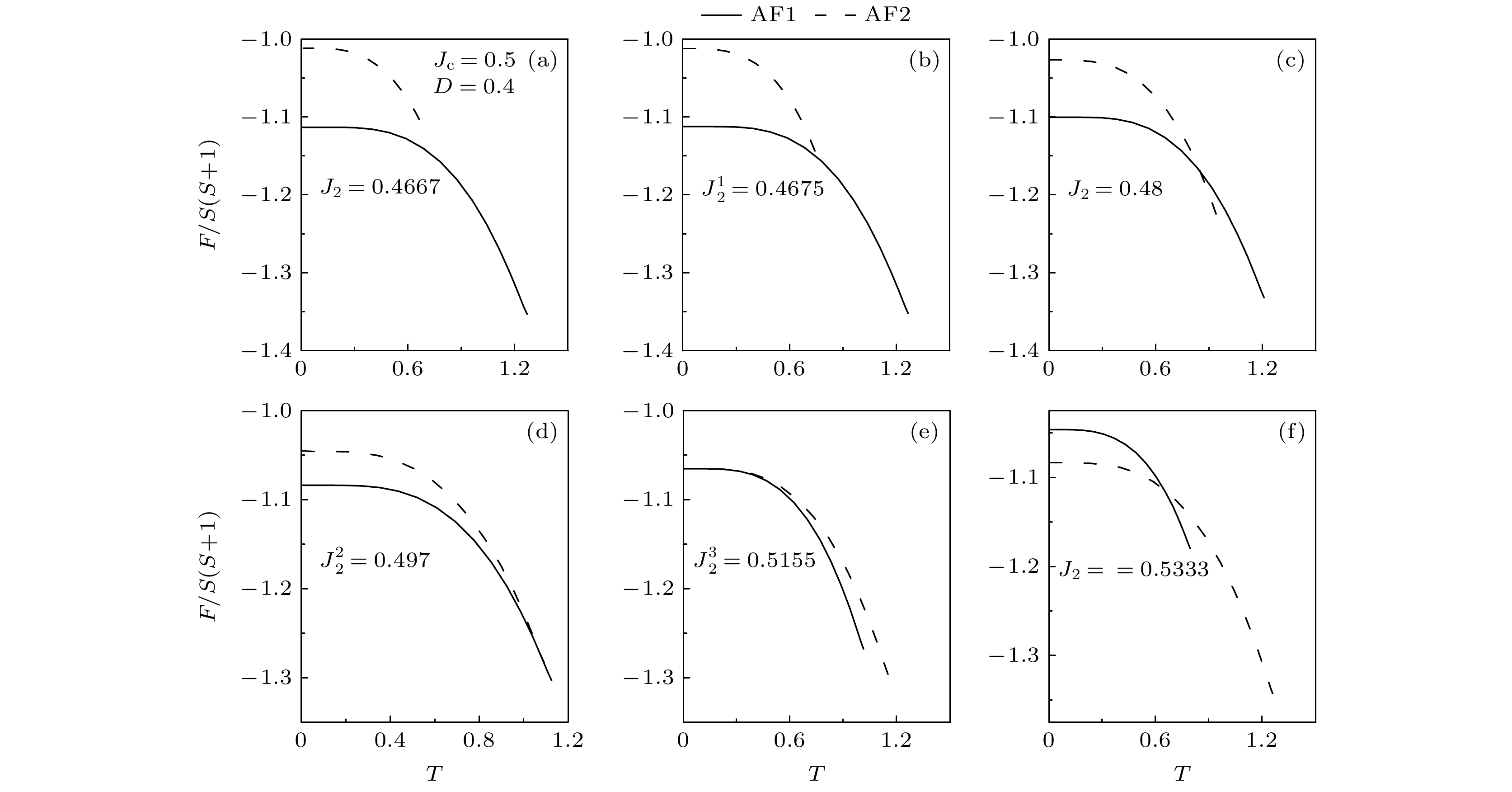-
In this paper, we investigate the phase transition of the spin-1 frustrated model on a square-lattice bilayer by the double-time Green’s function method. The effects of the interlayer coupling parameter
$ {J_c} $ and single-ion anisotropy D on phase transformation between the Nèel state (AF1) and collinear state (AF2) are explored. Our results show that if only the parameters$ {J_c} $ and D are not equal to zero at the same time, the two states can exist and have the same critical temperature at$ {J_2} = {J_1}/2 $ , which represents the nearest neighbor exchange. Under such parameters, a first-order phase transformation between these two states below the critical point can occur. For$ {J_2} \ne {J_1}/2 $ , although both states may exist, their Neel temperatures differ from each other. If the Nèel point of the AF1 (AF2) state is larger, then at very low temperature, the AF1 (AF2) state is more stable. Thus, in an intermediate temperature, a first-order phase transition between these two states may also occur.-
Keywords:
- antiferromagnetic /
- magnetic anisotropy /
- general theory and models of magnetic ordering /
- exchange and superexchange interactions
[1] Manojlović M, Pavkov M, Škrinjar M, PantićM, Kapor D, Stojanović S 2003 Phys. Rev. B 68 014435
 Google Scholar
Google Scholar
[2] Manojlović M, Pavkov M, Škrinjar M, Pantić M, Kapor D, Stojanović S 2005 Phys. Rev. B 73 132510
[3] Rutonjski M S, Radošević S M, Škrinjar M G, Pavkov-Hrvojević M V, Kapor D V, Pantić M R 2007 Phys. Rev. B 76 172506
[4] Liu G B, Liu B G 2009 J. Phys. :Condens. Matter 21 195701
 Google Scholar
Google Scholar
[5] Holt M, Sushkov O P, Stanek D, Uhrig G S 2011 Phys. Rev. B 83 144528
 Google Scholar
Google Scholar
[6] Johnston D C, McQueeney R J, Lake B, Honecker A, Zhitomirsky M E, Nath R, Furukawa Y, Antropov V P, Yogesh Singh 2011 Phys. Rev. B 84 094445
 Google Scholar
Google Scholar
[7] Mermin N D, Wagner H 1966 Phys. Rev. Lett. 17 1133
 Google Scholar
Google Scholar
[8] Schmalfuß D, Darradi R, Richter J, Schulenburg J, Ihle D 2006 Phys. Rev. Lett. 97 157201
 Google Scholar
Google Scholar
[9] Nunes W A, J Ricardo de Sousa, J Roberto Viana, Richter J 2010 J. Phys. :Condens. Matter 22 146004
 Google Scholar
Google Scholar
[10] Nunes W A, Roberto Viana, Ricardo de Sousa J 2011 J. Stat. Mech. ???? 05016
[11] Onofre R, Hamer C J, Oitmaa J 2011 J. Phys. :Condens. Matter 23 416001
 Google Scholar
Google Scholar
[12] Zhuo F, Jie Q L 2014 Phys. Rev. B 89 054418
 Google Scholar
Google Scholar
[13] Bishop R F, Li P H Y, Götze O, Richter J 2019 Phys. Rev. B 100 024401
 Google Scholar
Google Scholar
[14] 王怀玉 2012 凝聚态物理的格林函数理论 (北京: ) 第348页
Wang H Y 2012 Green’s Function in Condensed Matter Physics (Beijing: Alpha Science International Ltd and Science Press) p348 (in Chinese)
[15] Callen H B 1963 Phys. Rev. 130 890
 Google Scholar
Google Scholar
[16] Anderson F B, Callen H B 1964 Phys. Rev. 136 A1068
 Google Scholar
Google Scholar
[17] Fröbrich P, Jensen P J, Kuntz P J 2000 Eur. Phys. J. B 13 477
[18] Fröbrich P, Jensen P J, Kuntz P J, Ecker A 2000 Eur. Phys. J. B 18 579
 Google Scholar
Google Scholar
[19] Fröbrich P, Kuntz P J 2006 Phys. Rep. 432 223
 Google Scholar
Google Scholar
[20] Wang H Y, Zhai L J, Qian M 2014 J. Magn. Magn. Matter 354 309
 Google Scholar
Google Scholar
-
图 1 奈尔态和共线态的磁构型. (a), (b)和(c), (d)分别对应层间耦合为反铁磁和铁磁相互作用. 实心和空心圆圈分别描述的是自旋取向相上和向下
Figure 1. Spin configurations of the Néel and collinear states. (a), (b) and (c), (d) correspond to the interlayer coupling as antiferromagnetic and ferromagnetic interactions, respectively. The solid and empty circles represent the up-spins and down-spins, respectively.
图 2 不同参数时的相变温度
$ {T_N} $ 与$ {J_2} $ 之间的变化关系 (a)$ D = 0, {J_{\text{c}}} = 0.01, 0.2, 0.4, 0.6, 0.8, 1 $ ; (b)${J_{\text{c}}} = 0.5, D = 0, 0.2, $ $ 0.4, 0.6, 0.8, 1$ ; (c)$ {J_{\text{c}}} = 0.5, D = 0.4 $ ; (d)$ D = 0, {J_{\text{c}}} = - 0.01, - 0.2, $ $ - 0.4, - 0.6, - 0.8, - 1 $ ; (e)$ {J_{\text{c}}} = - 0.5, D = 0, 0.2, 0.4, 0.6, 0.8, 1 $ ; (f)$ {J_{\text{c}}} = - 0.5, D = 0.4 $ Figure 2. Transition temperature
$ {T_N} $ as a function of$ {J_2} $ for different parameters: (a)$ D = 0, $ $ {J_{\text{c}}} = 0.01, 0.2, 0.4, 0.6, 0.8, 1 $ ; (b)${J_{\text{c}}} = $ $ 0.5, D = 0, 0.2, 0.4, 0.6, 0.8, 1$ ; (c)$ {J_{\text{c}}} = 0.5, D = 0.4 $ ; (d)$ D = 0, {J_{\text{c}}} = - 0.01, - 0.2, - 0.4, - 0.6, - 0.8, - 1 $ ; (e)${J_{\text{c}}} = - 0.5, D = 0, $ $ 0.2, 0.4, 0.6, 0.8, 1$ ; (f)$ {J_{\text{c}}} = - 0.5, D = 0.4 $ .图 4 当
$ D = 0.2 $ 时, 不同$ {J_{\text{c}}} $ 值时的自由能F与温度T之间的变化关系 (a)$ {J_{\text{c}}} = 0 $ ; (b)$ {J_{\text{c}}} = 0.1 $ ; (c)$ {J_{\text{c}}} = 0.17 $ ; (d)$ {J_{\text{c}}} = 0.3 $ ; (e)$ {J_{\text{c}}} = 0.42 $ ; (f)$ {J_{\text{c}}} = 1 $ Figure 4. Free energy F as a function of temperature T for different
$ {J_{\text{c}}} $ values when$ D = 0.2 $ : (a)$ {J_{\text{c}}} = 0 $ ; (b)$ {J_{\text{c}}} = 0.1 $ ; (c)$ {J_{\text{c}}} = 0.17 $ ; (d)$ {J_{\text{c}}} = 0.3 $ ; (e)$ {J_{\text{c}}} = 0.42 $ ; (f)$ {J_{\text{c}}} = 1 $ .图 6 当
$ {J_{\text{c}}} = 0.5, D = 0.4 $ , 不同$ {J_2} $ 值时的自由能与温度之间的变化关系 (a)$ {J_2} = 0.4667 $ ; (b)$ {J_2} = 0.4675 $ ; (c)$ {J_2} = 0.48 $ ; (d)${J_2} = $ $ 0.4970.497$ ; (e)$ {J_2} = 0.5155 $ ; (f)$ {J_2} = 0.5333 $ Figure 6. Free energy as a function of temperature for different
$ {J_2} $ values when$ {J_{\text{c}}} = 0.5 $ and$ D = 0.4 $ : (a)$ {J_2} = 0.4667 $ ; (b)${J_2} = $ $ 0.4675$ ; (c)$ {J_2} = 0.48 $ ; (d)$ {J_2} = 0.497 $ ; (e)$ {J_2} = 0.5155 $ ; (f)$ {J_2} = 0.5333 $ .图 7 当
$ {J_{\text{c}}} = - 0.5, D = 0.4 $ 时, 不同$ {J_2} $ 值时的自由能与温度之间的变化关系 (a)$ {J_2} = 0.4667 $ ; (b)$ {J_2} = 0.467 $ ; (c)$ {J_2} = 0.48 $ ; (d)$ {J_2} = 0.4975 $ ; (e)$ {J_2} = 0.5156 $ ; (f)$ {J_2} = 0.5333 $ Figure 7. Free energy as a function of temperature for different
$ {J_2} $ values when$ {J_{\text{c}}} = - 0.5 $ and$ D = 0.4 $ : (a)$ {J_2} = 0.4667 $ ; (b)${J_2} = $ $ 0.467$ ; (c)$ {J_2} = 0.48 $ ; (d)$ {J_2} = 0.4975 $ ; (e)$ {J_2} = 0.5156 $ ; (f)$ {J_2} = 0.5333 $ . -
[1] Manojlović M, Pavkov M, Škrinjar M, PantićM, Kapor D, Stojanović S 2003 Phys. Rev. B 68 014435
 Google Scholar
Google Scholar
[2] Manojlović M, Pavkov M, Škrinjar M, Pantić M, Kapor D, Stojanović S 2005 Phys. Rev. B 73 132510
[3] Rutonjski M S, Radošević S M, Škrinjar M G, Pavkov-Hrvojević M V, Kapor D V, Pantić M R 2007 Phys. Rev. B 76 172506
[4] Liu G B, Liu B G 2009 J. Phys. :Condens. Matter 21 195701
 Google Scholar
Google Scholar
[5] Holt M, Sushkov O P, Stanek D, Uhrig G S 2011 Phys. Rev. B 83 144528
 Google Scholar
Google Scholar
[6] Johnston D C, McQueeney R J, Lake B, Honecker A, Zhitomirsky M E, Nath R, Furukawa Y, Antropov V P, Yogesh Singh 2011 Phys. Rev. B 84 094445
 Google Scholar
Google Scholar
[7] Mermin N D, Wagner H 1966 Phys. Rev. Lett. 17 1133
 Google Scholar
Google Scholar
[8] Schmalfuß D, Darradi R, Richter J, Schulenburg J, Ihle D 2006 Phys. Rev. Lett. 97 157201
 Google Scholar
Google Scholar
[9] Nunes W A, J Ricardo de Sousa, J Roberto Viana, Richter J 2010 J. Phys. :Condens. Matter 22 146004
 Google Scholar
Google Scholar
[10] Nunes W A, Roberto Viana, Ricardo de Sousa J 2011 J. Stat. Mech. ???? 05016
[11] Onofre R, Hamer C J, Oitmaa J 2011 J. Phys. :Condens. Matter 23 416001
 Google Scholar
Google Scholar
[12] Zhuo F, Jie Q L 2014 Phys. Rev. B 89 054418
 Google Scholar
Google Scholar
[13] Bishop R F, Li P H Y, Götze O, Richter J 2019 Phys. Rev. B 100 024401
 Google Scholar
Google Scholar
[14] 王怀玉 2012 凝聚态物理的格林函数理论 (北京: ) 第348页
Wang H Y 2012 Green’s Function in Condensed Matter Physics (Beijing: Alpha Science International Ltd and Science Press) p348 (in Chinese)
[15] Callen H B 1963 Phys. Rev. 130 890
 Google Scholar
Google Scholar
[16] Anderson F B, Callen H B 1964 Phys. Rev. 136 A1068
 Google Scholar
Google Scholar
[17] Fröbrich P, Jensen P J, Kuntz P J 2000 Eur. Phys. J. B 13 477
[18] Fröbrich P, Jensen P J, Kuntz P J, Ecker A 2000 Eur. Phys. J. B 18 579
 Google Scholar
Google Scholar
[19] Fröbrich P, Kuntz P J 2006 Phys. Rep. 432 223
 Google Scholar
Google Scholar
[20] Wang H Y, Zhai L J, Qian M 2014 J. Magn. Magn. Matter 354 309
 Google Scholar
Google Scholar
Catalog
Metrics
- Abstract views: 5828
- PDF Downloads: 61
- Cited By: 0


















 DownLoad:
DownLoad:

























































































